Tissue Conditioner Incorporating a Nano-Sized Surface Pre-Reacted Glass-Ionomer (S-PRG) Filler
Abstract
1. Introduction
2. Materials and Methods
2.1. Morphological Observation of S-PRG Particles
2.2. Preparation of Tissue Conditioners
2.3. Ion Release
2.4. Acid Buffering Capacity
2.5. Detail Reproduction
2.6. Consistency
2.7. Shore A0 Hardness
2.8. Surface Roughness
2.9. Candida albicans Adhesion
2.9.1. Specimen Preparation
2.9.2. Saliva Coating
2.9.3. Candida albicans Preparation and Adhesion
2.9.4. Fluorescent Staining and Observation
3. Results
3.1. Morphology of S-PRG Fillers
3.2. Ion Release
3.3. Acid Buffering Capacity
3.4. Detail Reproduction
3.5. Consistency
3.6. Shore A0 Hardness
3.7. Surface Roughness
3.8. Candida albicans Adhesion
4. Discussion
5. Conclusions
Author Contributions
Funding
Institutional Review Board Statement
Informed Consent Statement
Data Availability Statement
Acknowledgments
Conflicts of Interest
References
- Hong, G.; Li, Y.; Maeda, T.; Mizumachi, W.; Sadamori, S.; Hamada, T.; Murata, H. Influence of Storage Methods on the Surface Roughness of Tissue Conditioners. Dent. Mater. J. 2008, 27, 153–158. [Google Scholar] [CrossRef] [PubMed]
- Hermann, C.; Mesquita, M.F.; Consani, R.L.X.; Henriques, G.E.P. The Effect of Aging by Thermal Cycling and Mechanical Brushing on Resilient Denture Liner Hardness and Roughness. J. Prosthodont. 2008, 17, 318–322. [Google Scholar] [CrossRef] [PubMed]
- Pereira-Cenci, T.; Cury, A.D.B.; Crielaard, W.; Cate, J.M.T. Development of Candida-associated denture stomatitis: New insights. J. Appl. Oral Sci. 2008, 16, 86–94. [Google Scholar] [CrossRef]
- Ramage, G.; Tomsett, K.; Wickes, B.; Lopez-Ribot, J.; Redding, S.W. Denture stomatitis: A role for Candida biofilms. Oral Surg. Oral Med. Oral Pathol. Oral Radiol. Endodontol. 2004, 98, 53–59. [Google Scholar] [CrossRef] [PubMed]
- Araújo de Vasconcellos, A.; Araújo de Vasconcellos, A.; Chagas, R.B.; Gonçalves, L.M. Candida-Associated Denture Stomatitis:Clinical Relevant Aspects. Clin. Microbial. 2014, 3, 160. [Google Scholar] [CrossRef]
- Mayer, F.L.; Wilson, D.; Hube, B. Candida albicans pathogenicity mechanisms. Virulence 2013, 4, 119–128. [Google Scholar] [CrossRef] [PubMed]
- O’Donnell, L.E.; Smith, K.; Williams, C.; Nile, C.; Lappin, D.F.; Bradshaw, D.; Lambert, M.; Robertson, D.; Bagg, J.; Hannah, V.; et al. Dentures are a Reservoir for Respiratory Pathogens. J. Prosthodont. 2016, 25, 99–104. [Google Scholar] [CrossRef]
- Geerts, G.A.; Stuhlinger, M.E.; Basson, N.J. Effect of an antifungal denture liner on the saliva yeast count in patients with denture stomatitis: A pilot study. J. Oral. Rehabil. 2008, 35, 664–669. [Google Scholar] [CrossRef] [PubMed]
- Urban, V.M.; Seó, R.S.; Giannini, M.; Arrais, C.A.G. Superficial Distribution and Identification of Antifungal/Antimicrobial Agents on a Modified Tissue Conditioner by SEM-EDS Microanalysis: A Preliminary Study. J. Prosthodont. 2009, 18, 603–610. [Google Scholar] [CrossRef]
- Falah-Tafti, A.; Jafari, A.A.; Kamran, M.H.L.; Fallahzadeh, H.; Hayan, R.S. A Comparison of the eFficacy of Nystatin and Fluconazole Incorporated into Tissue Conditioner on the In Vitro Attachment and Colonization of Candida Albicans. Dent. Res. J. 2010, 7, 18–22. [Google Scholar]
- Bueno, M.; Urban, V.; Barbério, G.; Da Silva, W.J.; Porto, V.; Pinto, L.; Neppelenbroek, K. Effect of antimicrobial agents incorporated into resilient denture relines on the Candida albicans biofilm. Oral Dis. 2013, 21, 57–65. [Google Scholar] [CrossRef]
- Barua, D.R.; Basavanna, J.M.; Varghese, R.K. Efficacy of Neem Extract and Three Antimicrobial Agents Incorporated into Tissue Conditioner in Inhibiting the Growth of C. Albicans and S. Mutans. J. Clin. Diagn. Res. 2017, 11, ZC97–ZC101. [Google Scholar] [CrossRef]
- Radnai, M.; Whiley, R.; Friel, T.; Wright, P.S. Effect of antifungal gels incorporated into a tissue conditioning material on the growth of Candida albicans. Gerodontology 2009, 27, 292–296. [Google Scholar] [CrossRef]
- Urban, V.M.; De Souza, R.F.; Arrais, C.A.G.; Borsato, K.T.; Vaz, L.G. Effect of the Association of Nystatin with a Tissue Conditioner on its Ultimate Tensile Strength. J. Prosthodont. 2006, 15, 295–299. [Google Scholar] [CrossRef]
- Jadhav, V.; Kalavathy, N.; Kumar, R.; Shetty, M.; V, J.; M, S.M.; N, K.; R, K. Effect of 3 types of antifungal agents on hardness of 2 different commercially available tissue conditioners: An in-vitro study. SRM J. Res. Dent. Sci. 2013, 4, 150. [Google Scholar] [CrossRef]
- Saeed, A.; Haider, A.; Zahid, S.; Khan, S.A.; Faryal, R.; Kaleem, M. In-vitro antifungal efficacy of tissue conditioner-chitosan composites as potential treatment therapy for denture stomatitis. Int. J. Biol. Macromol. 2019, 125, 761–766. [Google Scholar] [CrossRef] [PubMed]
- Maior, L.D.F.S.; Maciel, P.P.; Ferreira, V.Y.N.; Dantas, C.D.L.G.; de Lima, J.M.; Castellano, L.; Batista, A.U.D.; Bonan, P.R.F. Antifungal activity and Shore A hardness of a tissue conditioner incorporated with terpinen-4-ol and cinnamaldehyde. Clin. Oral Investig. 2019, 23, 2837–2848. [Google Scholar] [CrossRef] [PubMed]
- Mousavi, S.A.; Ghotaslou, R.; Akbarzadeh, A.; Azima, N.; Aeinfar, A.; Khorramdel, A. Evaluation of antibacterial and antifungal properties of a tissue conditioner used in complete dentures after incorporation of ZnO‒Ag nanoparticles. J. Dent. Res. Dent. Clin. Dent. Prospect. 2019, 13, 11–18. [Google Scholar] [CrossRef]
- Ueshige, M.; Abe, Y.; Sato, Y.; Tsuga, K.; Akagawa, Y.; Ishii, M. Dynamic viscoelastic properties of antimicrobial tissue conditioners containing silver–zeolite. J. Dent. 1999, 27, 517–522. [Google Scholar] [CrossRef]
- Kanathila, H.; Krishna, P.D.; Bhat, A.M.; H, K.; Am, B.; D, K.P. The effectiveness of magnesium oxide combined with tissue conditioners in inhibiting the growth of Candida albicans: An in vitro study. Indian J. Dent. Res. 2011, 22, 613. [Google Scholar] [CrossRef] [PubMed]
- Takakusaki, K.; Fueki, K.; Tsutsumi, C.; Tsutsumi, Y.; Iwasaki, N.; Hanawa, T.; Takahashi, H.; Takakuda, K.; Wakabayashi, N. Effect of incorporation of surface pre-reacted glass ionomer filler in tissue conditioner on the inhibition of Candida albicans adhesion. Dent. Mater. J. 2018, 37, 453–459. [Google Scholar] [CrossRef] [PubMed]
- Ogawa, A.; Wada, T.; Mori, Y.; Uo, M. Time dependence of multi-ion absorption into human enamel from surface prereacted glass-ionomer (S-PRG) filler eluate. Dent. Mater. J. 2019, 38, 707–712. [Google Scholar] [CrossRef]
- Tamura, M.; Cueno, M.E.; Abe, K.; Kamio, N.; Ochiai, K.; Imai, K. Ions released from a S-PRG filler induces oxidative stress in Candida albicans inhibiting its growth and pathogenicity. Cell Stress Chaperones 2018, 23, 1337–1343. [Google Scholar] [CrossRef] [PubMed]
- Hotta, M.; Morikawa, T.; Tamura, D.; Kusakabe, S. Adherence of Streptococcus sanguinis and Streptococcus mutans to saliva-coated S-PRG resin blocks. Dent. Mater. J. 2014, 33, 261–267. [Google Scholar] [CrossRef] [PubMed]
- Nomura, R.; Morita, Y.; Matayoshi, S.; Nakano, K. Inhibitory effect of surface pre-reacted glass-ionomer (S-PRG) eluate against adhesion and colonization by Streptococcus mutans. Sci. Rep. 2018, 8, 1–18. [Google Scholar] [CrossRef] [PubMed]
- Kaga, M.; Kakuda, S.; Ida, Y.; Toshima, H.; Hashimoto, M.; Endo, K.; Sano, H. Inhibition of enamel demineralization by buffering effect of S-PRG filler-containing dental sealant. Eur. J. Oral Sci. 2013, 122, 78–83. [Google Scholar] [CrossRef] [PubMed]
- Navya, P.N.; Daima, H.K. Rational engineering of physicochemical properties of nanomaterials for biomedical applications with nanotoxicological perspectives. Nano Converg. 2016, 3, 1–14. [Google Scholar] [CrossRef]
- International Organization for Standardization. ISO 10193-1: Dentistry—Soft Lining Materials for Removable Partial Dentures—Part 1: Materials for Short-Term Use, 3rd ed.; ISO: Geneva, Switzerland, 2018. [Google Scholar]
- Murayama, R.; Matsuyoshi, S.; Shibasaki, S.; Tsuchiya, K.; Takimoto, M.; Kawamoto, R.; Kurokawa, H.; Miyazaki, M. The effect of coating material containing S-PRG filler on the prevention of enamel demineralization detected by optical coherence tomography. Jpn. J. Conserv. Dent. 2014, 57, 578–588. [Google Scholar]
- Thuy, T.T.; Nakagaki, H.; Kato, K.; Hung, P.A.; Inukai, J.; Tsuboi, S.; Nakagaki, H.; Hirose, M.N.; Igarashi, S.; Robinson, C. Effect of strontium in combination with fluoride on enamel remineralization in vitro. Arch Oral. Biol. 2008, 53, 1017–1022. [Google Scholar] [CrossRef]
- Shiiya, T.; Tomiyama, K.; Iizuka, J.; Hasegawa, H.; Kuramochi, E.; Fujino, F.; Ohashi, K.; Nihei, T.; Teranaka, T.; Mukai, Y. Effects of resin-based temporary filling materials against dentin demineralization. Dent. Mater. J. 2016, 35, 70–75. [Google Scholar] [CrossRef]
- Fujimoto, Y.; Iwasa, M.; Murayama, R.; Miyazaki, M.; Nagafuji, A.; Nakatsuka, T. Detection of ions released from S-PRG fillers and their modulation effect. Dent. Mater. J. 2010, 29, 392–397. [Google Scholar] [CrossRef] [PubMed]
- Tsutsumi, C.; Takakuda, K.; Wakabayashi, N. Reduction of Candida biofilm adhesion by incorporation of prereacted glass ionomer filler in denture base resin. J. Dent. 2016, 44, 37–43. [Google Scholar] [CrossRef] [PubMed]
- Yoshihara, K.; Nagaoka, N.; Maruo, Y.; Sano, H.; Yoshida, Y.; Van Meerbeek, B. Bacterial adhesion not inhibited by ion-releasing bioactive glass filler. Dent. Mater. 2017, 33, 723–734. [Google Scholar] [CrossRef]
- Miki, S.; Kitagawa, H.; Kitagawa, R.; Kiba, W.; Hayashi, M.; Imazato, S. Antibacterial activity of resin composites containing surface pre-reacted glass-ionomer (S-PRG) filler. Dent. Mater. 2016, 32, 1095–1102. [Google Scholar] [CrossRef] [PubMed]
- Kawasaki, K.; Kambara, M. Effects of Ion-Releasing Tooth-Coating Material on Demineralization of Bovine Tooth Enamel. Int. J. Dent. 2014, 2014, 1–7. [Google Scholar] [CrossRef]
- Kaga, M.; Masuta, J.; Hoshino, M.; Genchou, M.; Minamikawa, H.; Hashimoto, M.; Yawaka, Y. Mechanical properties and ions release of S-PRG filler-containing pit and fissure sealant. Nano Biomed. 2011, 3, 191–199. [Google Scholar]
- Wang, Y.; Kaga, M.; Kajiwara, D.; Minamikawa, H.; Kakuda, S.; Hashimoto, M.; Yawaka, Y. Ion release and buffering capacity of S-PRG filler-containing pit and fissure sealant in lactic acid. Nano Biomed. 2011, 3, 275–281. [Google Scholar]
- Shimazu, K.; Ogata, K.; Karibe, H. Evaluation of the ion-releasing and recharging abilities of a resin-based fissure sealant containing S-PRG filler. Dent. Mater. J. 2011, 30, 923–927. [Google Scholar] [CrossRef]
- Han, L.; Okiji, T. Evaluation of the ions release/incorporation of the prototype S-PRG filler-containing endodontic sealer. Dent. Mater. J. 2011, 30, 898–903. [Google Scholar] [CrossRef]
- Nakajo, K.; Imazato, S.; Takahashi, Y.; Kiba, W.; Ebisu, S.; Takahashi, N. Fluoride released from glass-ionomer cement is responsible to inhibit the acid production of caries-related oral streptococci. Dent. Mater. 2009, 25, 703–708. [Google Scholar] [CrossRef]
- Nili, M.; Abdoulhamidi, H. A comparison of the reproduction of surface detail of three tissue conditioning materials over time. J. Dent. Shiraz. Univ. Med. Sci. 2012, 13, 120–125. [Google Scholar]
- Jones, D.; Sutow, E.; Hall, G.; Tobin, W.; Graham, B. Dental soft polymers: Plasticizer composition and leachability. Dent. Mater. 1988, 4, 1–7. [Google Scholar] [CrossRef]
- Urban, V.M.; Lima, T.F.; Bueno, M.G.; Giannini, M.; Filho, J.N.A.; De Almeida, A.L.P.F.; Neppelenbroek, K. Effect of the Addition of Antimicrobial Agents on Shore A Hardness and Roughness of Soft Lining Materials. J. Prosthodont. 2014, 24, 207–214. [Google Scholar] [CrossRef] [PubMed]
- Bulad, K.; Taylor, R.L.; Verran, J.; Mccord, J.F. Colonization and penetration of denture soft lining materials by Candida albicans. Dent. Mater. 2004, 20, 167–175. [Google Scholar] [CrossRef]
- De Dantas, L.C.M.; da Silva-Neto, J.P.; Dantas, T.S.; Naves, L.Z.; das Neves, F.D.; da Mota, A.S. Bacterial adhesion and surface roughness for different clinical techniques for acrylic polymethyl methacrylate. Int. J. Dent. 2016, 2016, 8685796. [Google Scholar] [CrossRef]
- Machado, A.L.; Giampaolo, E.T.; Vergani, C.E.; Pavarina, A.C.; Salles, D.D.S.L.; Jorge, J.H. Weight loss and changes in surface roughness of denture base and reline materials after simulated toothbrushing in vitro. Gerodontology 2012, 29, e121–e127. [Google Scholar] [CrossRef] [PubMed]
- Pointer, B.R.; Boyer, M.P.; Schmidt, M. Boric acid destabilizes the hyphal cytoskeleton and inhibits invasive growth of Candida albicans. Yeast 2015, 32, 389–398. [Google Scholar] [CrossRef]
- McCall, A.D.; Pathirana, R.; Prabhakar, A.; Cullen, P.J.; Edgerton, M. Candida albicans biofilm development is governed by cooperative attachment and adhesion maintenance proteins. NPJ Biofilms Microbiomes 2019, 5, 1–12. [Google Scholar] [CrossRef]
- Lontsi Djimeli, C.; Tamsa Arfao, A.; Ewoti, O.; Bricheux, G.; Nola, M.; Sime-Ngando, T. Adhesion of Candida albicans to polythene in Sodium hypochlorite disinfected aquatic microcosm and potential impact of cell surface properties. Curr. Res. Microbiol. Biotechnol. 2014, 2, 479–489. [Google Scholar]

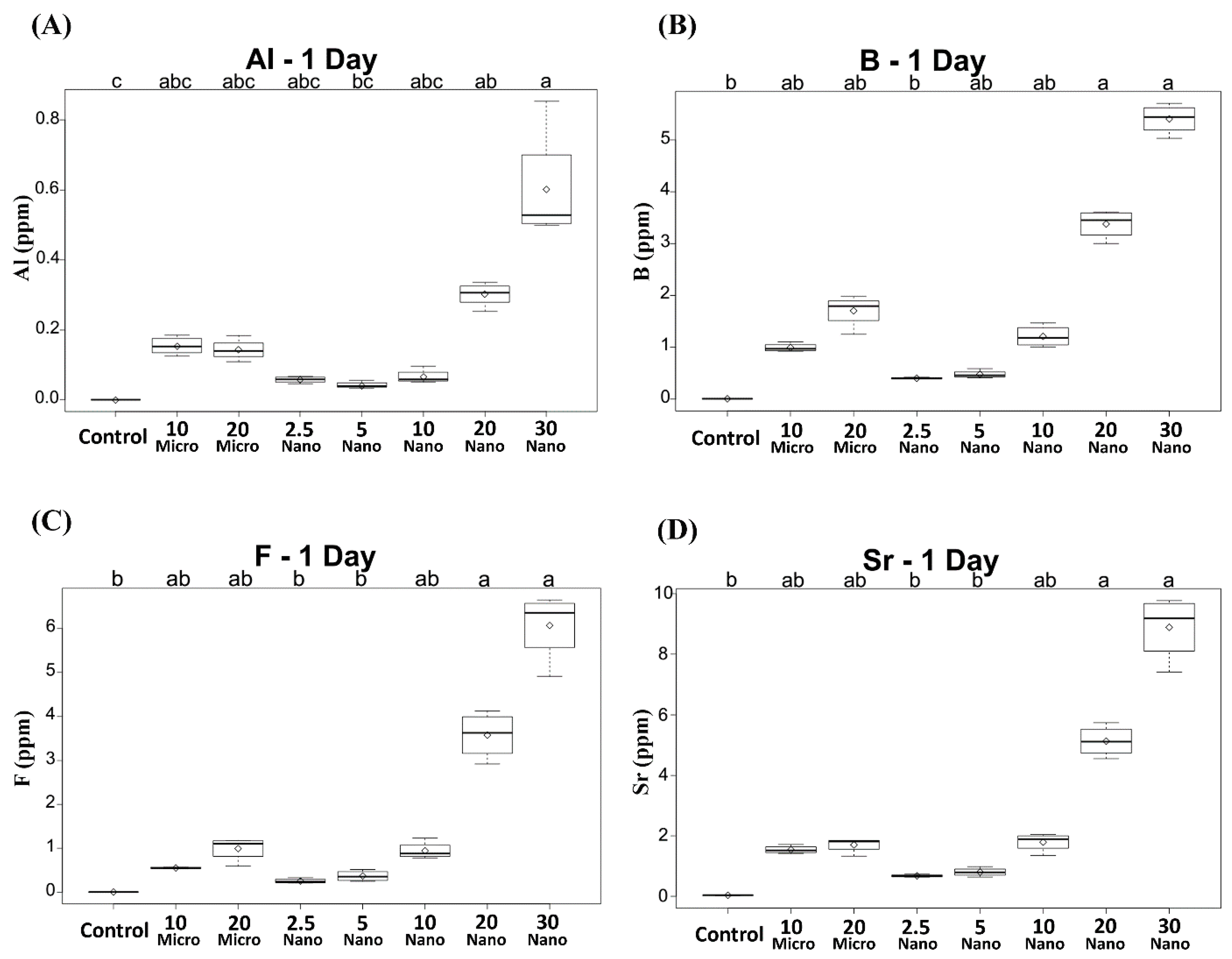
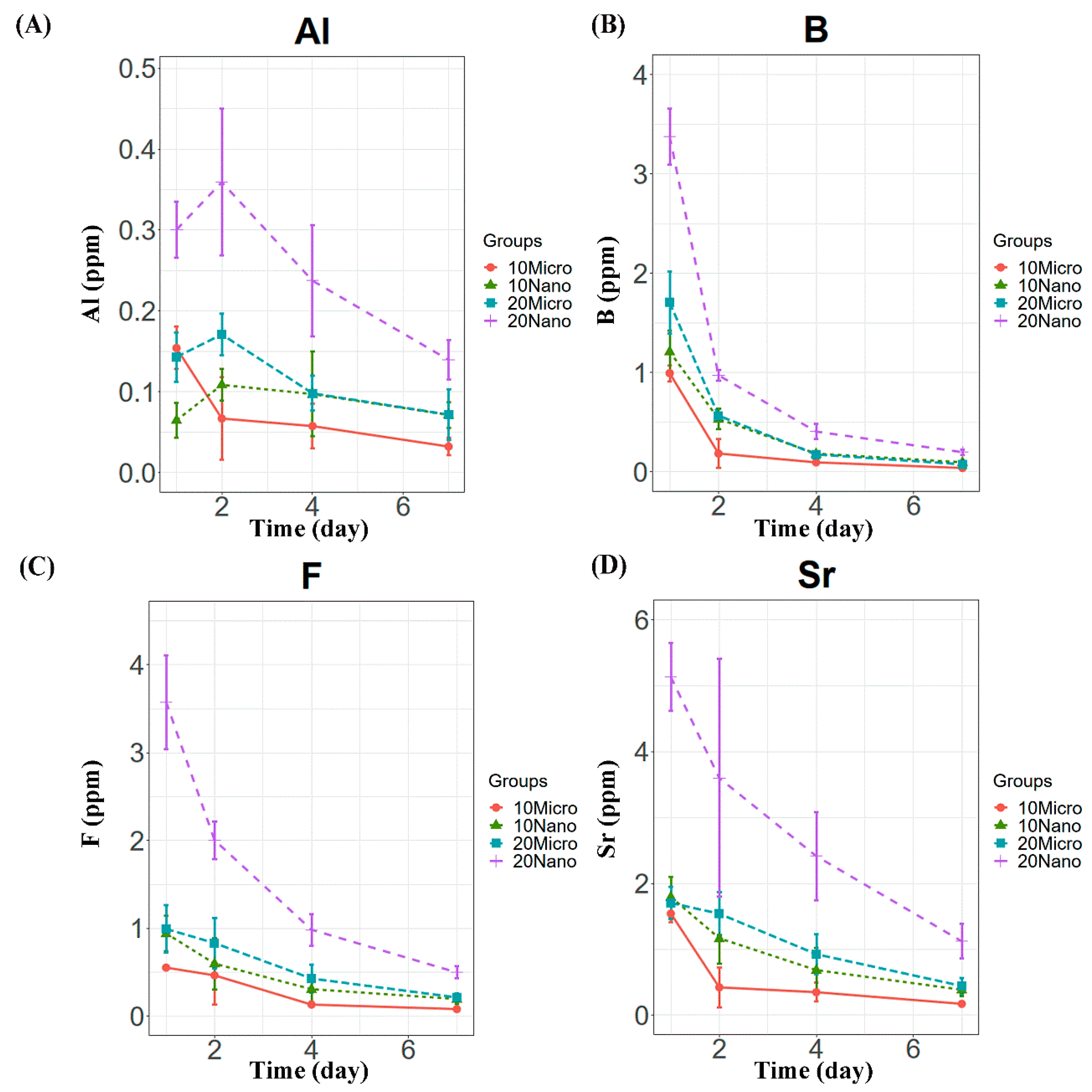
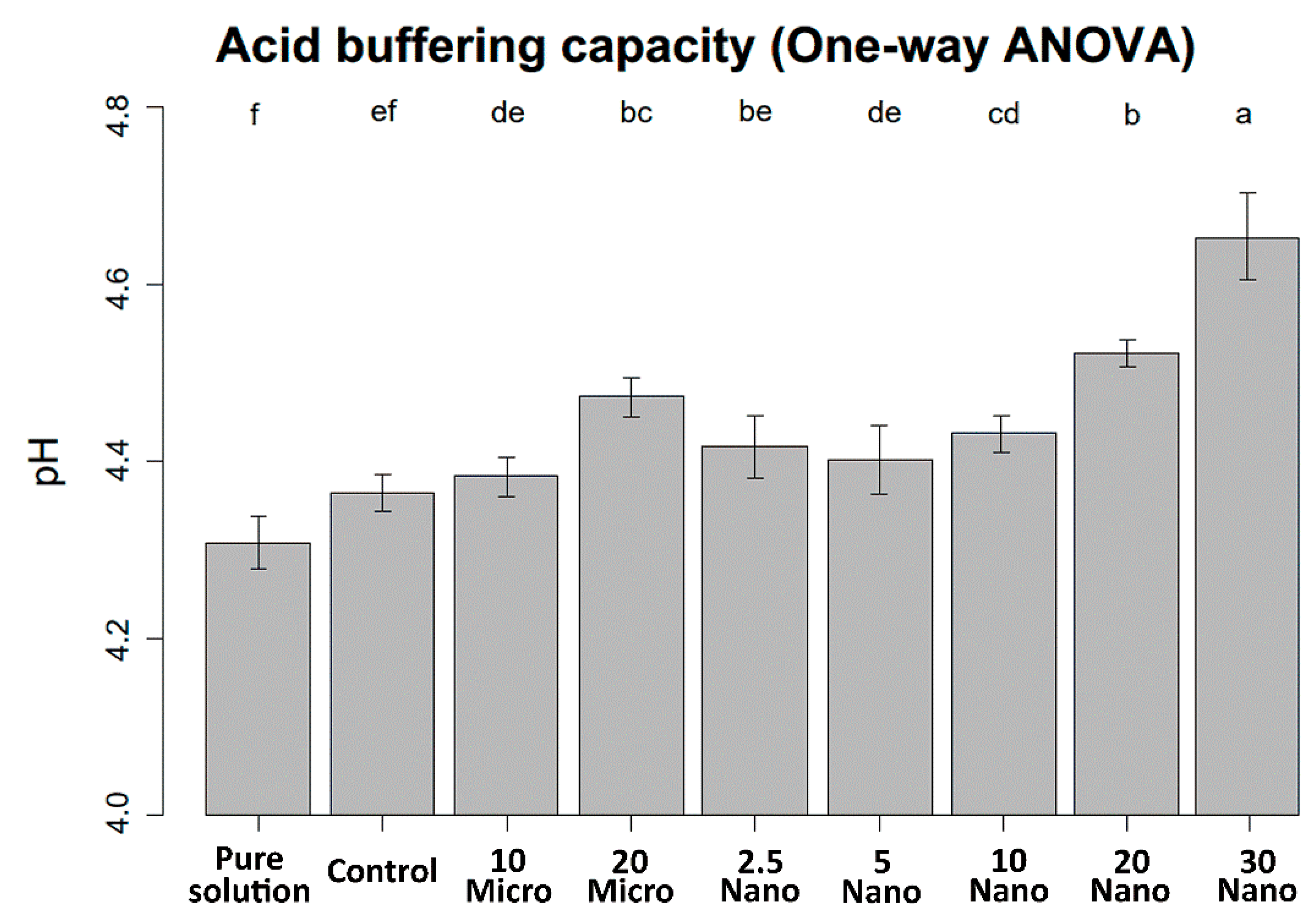
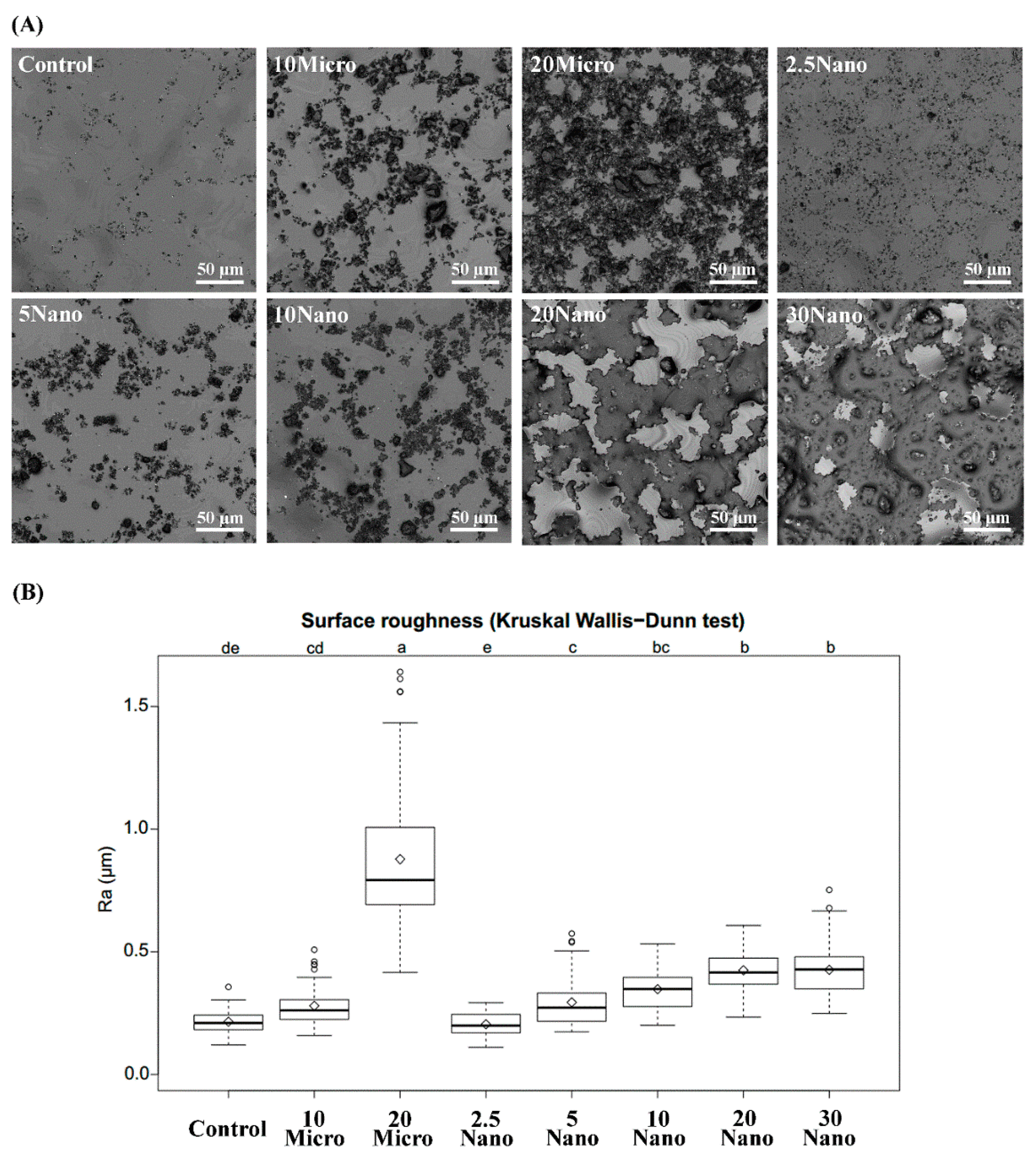
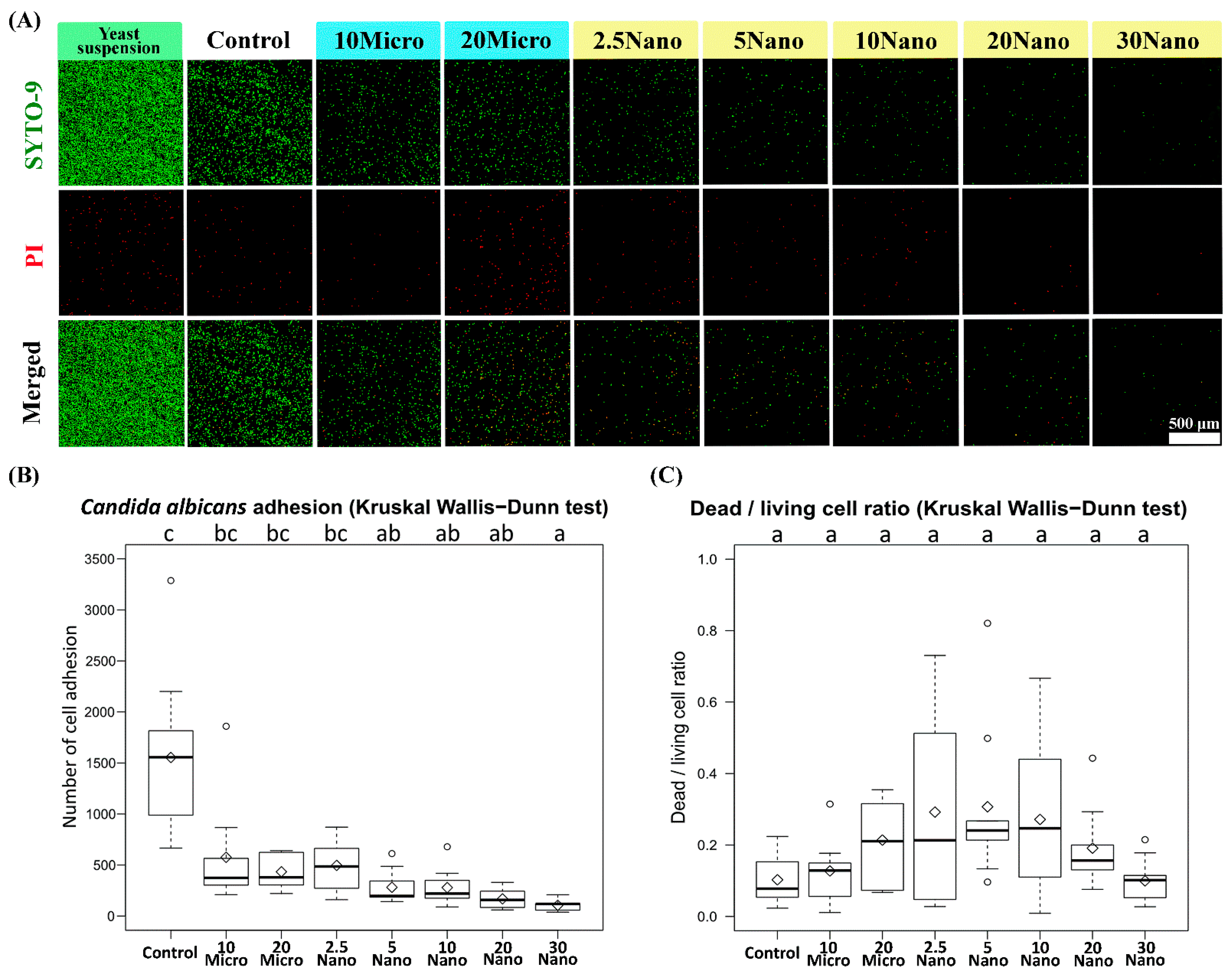
| Material | Trade Name | Composition | Manufacturer | Batch Code |
|---|---|---|---|---|
| Tissue conditioner (powder) | Shofu tissue conditioner II | Polyethyl methacrylate | Shofu, Kyoto, Japan | 1208201 |
| Tissue conditioner (liquid) | Shofu tissue conditioner II | Di-n-butyl sebacate and absolute ethanol | Shofu | 111847 |
| S-PRG microfiller | - | Pure S-PRG microfiller | Shofu | 091901 |
| S-PRG nanofiller | - | Pure S-PRG nanofiller | Shofu | 091902 |
| Groups | S-PRG Filler | Tissue Conditioner Powder, wt% | |
|---|---|---|---|
| Particle Size | wt% | ||
| 10 Micro | Micro | 10 | 90 |
| 20 Micro | Micro | 20 | 80 |
| 2.5 Nano | Nano | 2.5 | 97.5 |
| 5 Nano | Nano | 5 | 95 |
| 10 Nano | Nano | 10 | 90 |
| 20 Nano | Nano | 20 | 80 |
| 30 Nano | Nano | 30 | 70 |
| Control | - | 0 | 100 |
| Groups | Consistency (mm) | Detail Reproduction (µm) | Shore A0 Hardness | ||||
|---|---|---|---|---|---|---|---|
| 2 h | 7 Days | ||||||
| Mean * | SD | Mean | SD | Mean | SD | ||
| Control | 47.30 c | 1.08 | 20, 50, 75 | 3.47 | 0.74 | 7.87 | 0.91 |
| 10 Micro | 52.73 abc | 0.44 | 20, 50, 75 | 3.67 | 0.62 | 6.07 | 0.46 |
| 20 Micro | 53.40 ab | 0.50 | 20, 50, 75 | 3.60 | 0.50 | 5.47 | 0.64 |
| 2.5 Nano | 48.90 abc | 0.59 | 20, 50, 75 | 4.33 | 0.49 | 7.80 | 0.77 |
| 5 Nano | 48.55 bc | 0.29 | 20, 50, 75 | 4.20 | 0.56 | 7.53 | 0.74 |
| 10 Nano | 49.40 abc | 0.46 | 20, 50, 75 | 4.13 | 0.64 | 6.13 | 0.74 |
| 20 Nano | 50.85 abc | 0.82 | 20, 50, 75 | 2.67 | 0.62 | 4.07 | 0.70 |
| 30 Nano | 54.68 a | 2.17 | 20, 50, 75 | 1.0 | 0.00 | 2.00 | 0.53 |
Publisher’s Note: MDPI stays neutral with regard to jurisdictional claims in published maps and institutional affiliations. |
© 2021 by the authors. Licensee MDPI, Basel, Switzerland. This article is an open access article distributed under the terms and conditions of the Creative Commons Attribution (CC BY) license (https://creativecommons.org/licenses/by/4.0/).
Share and Cite
Tonprasong, W.; Inokoshi, M.; Tamura, M.; Uo, M.; Wada, T.; Takahashi, R.; Hatano, K.; Shimizubata, M.; Minakuchi, S. Tissue Conditioner Incorporating a Nano-Sized Surface Pre-Reacted Glass-Ionomer (S-PRG) Filler. Materials 2021, 14, 6648. https://doi.org/10.3390/ma14216648
Tonprasong W, Inokoshi M, Tamura M, Uo M, Wada T, Takahashi R, Hatano K, Shimizubata M, Minakuchi S. Tissue Conditioner Incorporating a Nano-Sized Surface Pre-Reacted Glass-Ionomer (S-PRG) Filler. Materials. 2021; 14(21):6648. https://doi.org/10.3390/ma14216648
Chicago/Turabian StyleTonprasong, Watcharapong, Masanao Inokoshi, Muneaki Tamura, Motohiro Uo, Takahiro Wada, Rena Takahashi, Keita Hatano, Makoto Shimizubata, and Shunsuke Minakuchi. 2021. "Tissue Conditioner Incorporating a Nano-Sized Surface Pre-Reacted Glass-Ionomer (S-PRG) Filler" Materials 14, no. 21: 6648. https://doi.org/10.3390/ma14216648
APA StyleTonprasong, W., Inokoshi, M., Tamura, M., Uo, M., Wada, T., Takahashi, R., Hatano, K., Shimizubata, M., & Minakuchi, S. (2021). Tissue Conditioner Incorporating a Nano-Sized Surface Pre-Reacted Glass-Ionomer (S-PRG) Filler. Materials, 14(21), 6648. https://doi.org/10.3390/ma14216648






